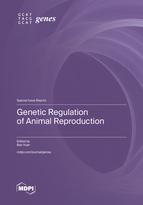Genetic Regulation of Animal Reproduction
A special issue of Genes (ISSN 2073-4425). This special issue belongs to the section "Animal Genetics and Genomics".
Deadline for manuscript submissions: closed (15 September 2023) | Viewed by 17353
Special Issue Editor
Special Issue Information
Dear Colleagues,
Reproduction is an instinct of animals, and it is the most important instinct. The stable conduct of animal reproduction activities is what makes populations continue. Reproductive behavior, as the most basic life activity of livestock, is the guarantee of livestock production and the basis of good breeding. Deepening the molecular regulation mechanism of animal reproduction will help to better improve the efficiency of livestock production and meet the increasing demands of peoples’ lives. With the continuous advancement of epigenetic research and the wide application of various omics techniques, a large number of histone modifications, promoter elements, enhancers, noncoding RNAs, RNA methylation modifications, etc., have been successfully explored. These epigenetic regulatory mechanisms have provided us with a deeper understanding of the inner workings of animal reproduction, but have also led to more mysteries. This Special Issue of Genes will encompass both review and original research articles by experts in the field of epigenetics, with a primary focus on animal reproduction. In particular, original research in the field of reproductive regulation molecular mechanisms in domestic animals and rare animals will be more popular. New theories and technologies related to model animal reproduction are also within the scope of this research.
Prof. Dr. Bao Yuan
Guest Editor
Manuscript Submission Information
Manuscripts should be submitted online at www.mdpi.com by registering and logging in to this website. Once you are registered, click here to go to the submission form. Manuscripts can be submitted until the deadline. All submissions that pass pre-check are peer-reviewed. Accepted papers will be published continuously in the journal (as soon as accepted) and will be listed together on the special issue website. Research articles, review articles as well as short communications are invited. For planned papers, a title and short abstract (about 100 words) can be sent to the Editorial Office for announcement on this website.
Submitted manuscripts should not have been published previously, nor be under consideration for publication elsewhere (except conference proceedings papers). All manuscripts are thoroughly refereed through a single-blind peer-review process. A guide for authors and other relevant information for submission of manuscripts is available on the Instructions for Authors page. Genes is an international peer-reviewed open access monthly journal published by MDPI.
Please visit the Instructions for Authors page before submitting a manuscript. The Article Processing Charge (APC) for publication in this open access journal is 2600 CHF (Swiss Francs). Submitted papers should be well formatted and use good English. Authors may use MDPI's English editing service prior to publication or during author revisions.
Keywords
- animals
- genetics
- epigenetics
- reproductive regulation
- omics techniques and data
- molecular mechanisms







